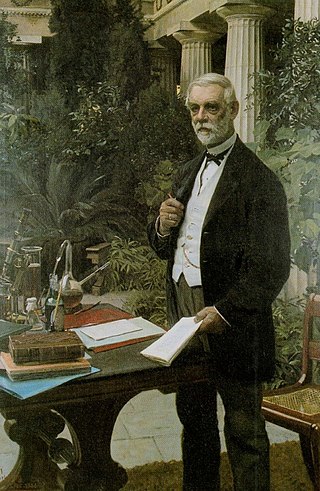
Jacob Christian Jacobsen, mostly known as J. C. Jacobsen, was a Danish industrialist and philanthropist best known for founding the brewery Carlsberg.

Carlsberg A/S is a Danish multinational brewer. Founded in 1847 by J. C. Jacobsen, the company's headquarters is in Copenhagen, Denmark. Since Jacobsen's death in 1887, the majority owner of the company has been the Carlsberg Foundation. The company's flagship brand is Carlsberg. Other brands include Tuborg, Kronenbourg, Somersby cider, Holsten, Neptun, Belgian Grimbergen, Fix, one of Greece's oldest brands and more than 500 local beers. The company employs around 41,000 people, primarily in Europe and Asia. Carlsberg is currently the 6th largest brewery in the world based on revenue.
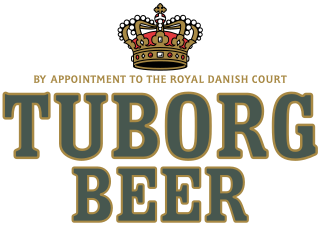
Tuborg is a Danish brewing company founded in 1873 on a harbour in Hellerup, to the north of Copenhagen, Denmark. Since 1970 it has been part of the Carlsberg Group. The brewery's flagship, the Tuborg pilsner, was brewed for the first time in 1880.

Valby ( ) is one of the 10 official districts of Copenhagen Municipality, Denmark. It is in the southwestern corner of Copenhagen Municipality, and has a mixture of different types of housing. This includes apartment blocks, terraced housing, areas with single-family houses and allotments, plus the remaining part of the old Valby village, around which the district has formed, intermingled with past and present industrial sites.

Wrexham Lager is a lager brewed in Wrexham, north-east Wales, tracing its heritage to 1881. After the original brewery's closure in 2000, the brand was revived by the Roberts family in 2011 using an older recipe.

Faxe Brewery is a Danish brewery located in the town of Faxe. The brewery was founded in 1901 by Nikoline and Conrad Nielsen. It was called Fakse Dampbryggeri, but after her husband's death, Nikoline christened the brewery Faxe Bryggeri. And it is best known for its strong export beers. In 1989 Faxe Bryggeri merged with Bryggerigruppen, which later developed into Royal Unibrew. It is known around Germany for its 5% 1 litre cans, North America for its 8% and 10% 500mL cans, and Denmark, where it is produced, especially in Norway and Greenland. In addition to beer, it produces soft drinks such as Faxe Kondi, Nikoline, Ceres Red Soda, Thor Passion, Albani Tonic Water and Pepsi, Mountain Dew, 7 Up and Mirinda by license from USA.

Carlsberg, is an area located straddling the border of Valby and Vesterbro districts in central Copenhagen, Denmark approximately 2.4 km from the City Hall Square. The area emerged when J.C. Jacobsen founded his original brewery in the district in 1847. The first brewing took place on 11 November 1847 and production continued until 30 October 2008, when production was moved to Fredericia in Jutland. The Jacobsen House Brewery is however still located in the district and produces specialty beers. The entire brewery grounds spread over more than 30 hectares and is currently being transformed into a new city district in Copenhagen.

Fotografisk Center is an exhibition space in Copenhagen, Denmark, dedicated to international and Danish photographic art. Since 1 January 2016 it has been based in the Copenhagen Meat Packing District at Staldgade 16, 1799 Copenhagen V.

The Ny Carlsberg Brewhouse is a historic, listed building in the Carlsberg district of Copenhagen, Denmark, on the border between Vesterbro and Valby.

The Dipylon, or the Double Gate, is a landmark structure which spans Ny Carlsberg Vej in the Carlsberg area of Copenhagen, Denmark. Part of the now decommissioned Carlsberg Brewery site, it combines a double-arched gateway, from which it takes its name, with a clock tower.
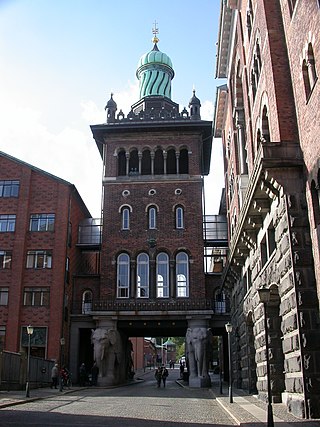
The Elephant Tower is the most famous landmark of the Carlsberg district in Copenhagen, Denmark, the original brewery site of the Carlsberg Breweries. The tower takes its name from four large granite elephants which flank the gate, standing back to back carrying the tower on their backs.

Carlsberg Lighthouse, also known as the Lime Tower after the limestone which is its dominating building material, is a former lighthouse located in the Carlsberg area of Copenhagen, Denmark.
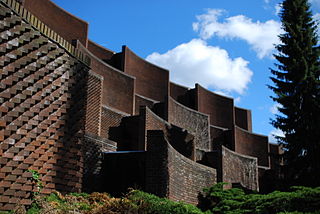
The J. C. Jacobsen Garden, also known as the Academy Garden, is a public garden in the Carlsberg area of Copenhagen, Denmark. The main entrance is through a pergola on the left-hand side of the Tap E building, a former bottling plant which now serves as a cultural venue.
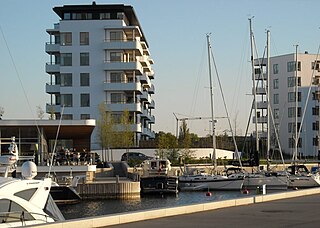
Tuborg Havn or Port of Tuborg is a marina and surrounding mixed-use neighbourhood in the Hellerup district of Copenhagen, Denmark. Located on a peninsula on the north side of Svanemølle Bay, just north of the border to Copenhagen Municipality, it is the result of a redevelopment of the former industrial site of Tuborg Breweries which ceased operations in 1996. The marina is operated by the Royal Danish Yacht Club (KDY) which also has their club house at the site. Other local landmarks include the Experimentarium science centre, the Waterfront shopping centre and the Saxo Bank headquarters. The port is located a 15-minute walk from the S-trains stations Svanemøllen (south) or Hellerup (north).

Rahbeks Allé is a street located on the border between Frederiksberg and Vesterbro in Copenhagen, Denmark. It runs from Vesterbrogade in the northeast to the corner of Søndermarken in the southwest where it joins Pile Alle just before it turns into Valby Langgade on the border to Valby.The former Carlsberg brewery site which is under transformation into a new, dense neighbourhood is located on the south side of the street. Its north side is lined with low, mostly three-storey late-19th century apartment buildings with small front gardens.
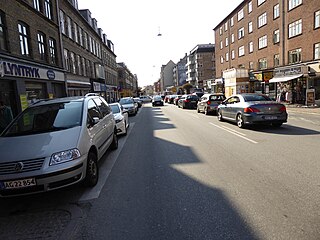
Valby Langgade is one of the main streets of the Valby district of Copenhagen, Denmark. The c. 3.2 km long street runs from the southern end of Pile Allé and the Carlsberg neighbourhood in the east to Roskildevej at Damhus Lake in the west. The square and side street Valby Tingsted was the centre of the original village of Valby.

Carl Jacobsens Vej is a street in the Valby district of Copenhagen, Denmark. It runs from Sjælør Boulevard on the rear side of Vestre Cemetery in the east to Gammel Køge Landevej in the west. The street is lined by a mixture of converted industrial complexes from the beginning of the 20th century, building society developments and modern apartment buildings from the 2010s.

Hotel Ottilia is a 155-room boutique hotel operated by Brøchner Hotels in two former brewery buildings in the Carlsberg area of Copenhagen, Denmark. The older building, known as the Malt Chamber, is from 1881 and was designed by Vilhelm Dahlerup. The other one, Storage Cellar 3, was built to a Functionalist design in 1969. Both buildings are listed in the Danish registry of protected buildings and places. The hotel opened in 2019. It takes its name after Ottilia Jacobsen, the wife of second generation Carlsberg brewer Carl Jacobsen.

Rahbeks Allé Brewery is a former brewery at Rahbeks Allé 3–11 in Copenhagen, Denmark. The brewery was founded in 1860 and merged with several other breweries under the name De Forenede Bryggerier in 1890. It was from 1923 operated under the name Kongens Bryghus and the site was decommissioned when De Forenede Bryggerier was acquired by Carlsberg Group in 1969. The buildings—a group of red brick buildings from 1860-61 by Jens Eckersberg and a tall, round silo from 1857 designed by Tyge Hvass—have now been converted into apartments.

Ny Carlsberg Vej is a street in the Vesterbro district of Copenhagen, Denmark. It runs from Sønder Boulevard in the east to the point where Pile Allé turns into Valby Langgade at the southeastern corner of the park Søndermarken in the west. The last cobbled part of the street passes through the Carlsberg neighbourhood. This section of the street is spanned by the Dipylon Building and the Elephant Tower, both of which were designed by Vilhelm Dahlerup in the ornate Historicist style and are among the most iconic buildings of the former Carlsberg brewery site.




















